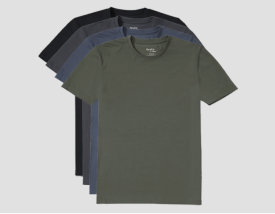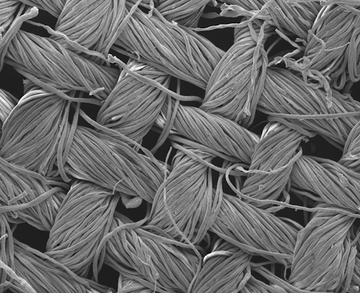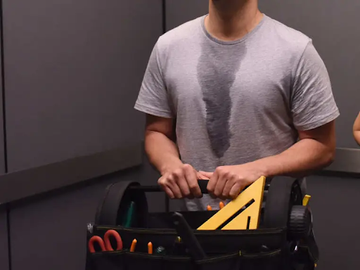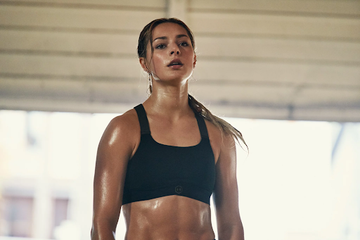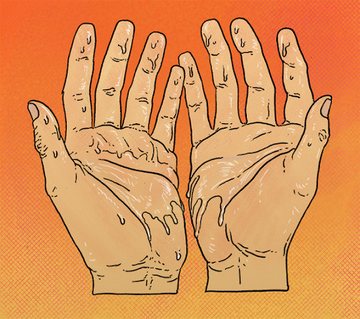You’ve probably read somewhere (perhaps here) that moisture-wicking fabrics are must-haves for heavy sweating, but maybe you’re not sold yet. Are you one of those “I need to see it to believe it” type of people?
If so, you need an explanation as to how moisture-wicking fabrics do what they claim. This post will do just that. We’ll break down the science and engineering of how moisture-wicking fabrics work and why they’re superior at keeping you dry.
For the Love (or Hate) of Water
To understand how moisture-wicking fabrics work, let’s briefly revisit your high school chemistry class. Remember those diagrams of water’s molecular structure? It has two hydrogen atoms sitting at the top of one oxygen atom, like ears. This produces a slight negative charge near the oxygen atom and a slight positive charge near the hydrogen ones.
This gives water magnetic properties so that it can stick to other molecules including the molecules on certain clothing fibres. Naturally, some fibres attract or repel water due to their own molecular structure.
With that said, the fibres of clothing material generally fall in one of two categories: hydrophilic and hydrophobic.
Hydrophilic fibres absorb water since their molecules bond with water molecules. Water clings to these surfaces. Moisture absorbing fabrics such as cotton are highly hydrophilic.
Hydrophobic fibres repel water since their molecular structure doesn’t allow water molecules to easily bond with them. Water rolls off of these surfaces. Fibres such as polyester are hydrophobic (since they’re oil-based).
This is where moisture-wicking begins. Water bonds to the molecules of hydrophilic fibres, which leads to water absorption while the molecules of hydrophilic fibres push water away. The best moisture-wicking fabrics contain both hydrophilic and hydrophobic properties. Here’s why: relying on just one type of fibre may not give you the optimal level of dryness.
Cotton is a good example of this. It’s naturally hydrophilic, meaning it absorbs plenty of water, but since it lacks hydrophobic ability, it doesn’t repel any water and takes longer to dry.
Wool, on the other hand, (especially merino wool), is hydrophobic (exterior fibres) and hydrophilic (interior fibres). This mixture allows for a push-pull action, where it can absorb water (ie. sweat) and then push it away.
But this doesn’t explain it all. There are other forces at work that actually make water travel throughout the fabric.
Moisture-Wicking Physics: Gravity, Adhesion and Cohesion
Gravity has a tremendous effect on water - that’s why rain falls in the first place. Yet still, water resists gravity all the time and it’s the reason why moisture-wicking fabrics can pull water upwards.
To illustrate this, think of how plants consume water. They draw water through their roots, pulling it from the ground and up in the tree trunk, nourishing stems and leaves. Plants wouldn’t survive without this ability and this is an example of capillary action at work. A similar thing happens in moisture-wicking fabrics.
The main force at work here is adhesion (although cohesion plays a role as well). Adhesion refers to molecules of different substances being attracted to each other (ie. water and oil), whereas cohesion is the attraction of similar molecules (ie. water molecules attracting water molecules).
With capillary action, adhesion pulls water molecules upward along a surface, giving it an almost anti-gravity-like motion. This occurs when the attraction between the fibre’s molecules is stronger than the attraction between the water molecules themselves.
Of course, capillary action isn’t totally resistant to gravity and factors such as surface tension limit how far upwards water can travel. In a moisture-wicking fabric, the water travels through tiny tubes called micropores.
Moisture-wicking also occurs horizontally as well. In other words, water travels across fabrics and can spread out. Ideally, the best fabrics allow for a more widespread transfer of water because this prevents one spot from getting too wet, which results in a long time to dry.
For instance, the fibre structure in polyester pulls water throughout the material, so that moisture doesn’t collect all in one spot. This is why polyester and similar materials dry fast. Cotton, on the other hand, absorbs moisture all in one spot, hence why it takes longer to dry.
Hygroscopy
The third element to moisture-wicking works is by means of how it turns moisture into vapour.
This is called hygroscopy, or more simply, “moisture regain”. During this process, the fabric takes the moisture it has absorbed and then releases the vapour into the air.
The more vapour a fabric releases, the better it is at wicking moisture away. The most effective moisture-wicking fibres release larger amounts of vapour into the air, making them better at keeping you dry. For example, wool releases twice as much moisture as cotton does, hence why it is a better moisture-wicking fabric than cotton is.
Putting it All Together
Moisture-wicking fabrics may all of a sudden seem more complex than you would have imagined. And that’s because they are. With that said, you can break down how these materials work into five steps.
- Hydrophilic fibres pull water since water molecules naturally bond with the molecules of these fibres.
- Hydrophobic fibres push water since water molecules don’t bond with the molecules of these fibres.
- Capillary action occurs through the force of adhesion, pulling water molecules upward.
- The best moisture-wicking fabrics pull water upward and outward
- They also rely on hygroscopy to release moisture vapour into the air
Of course, some fabrics are more effective at wicking moisture compared to others. We’ve discussed the most effective ones in another post, so be sure to give that read-through. Of course, many moisture-wicking fabrics contain a blend of different materials to provide multiple benefits.
Our own line of NEAT Apparel moisture-wicking t-shirts contains a blend of fabrics to give you a mix of moisture-wicking and absorbing power and breathability. Most importantly, they’re comfortable to wear as well. All of which is a testament to science.
